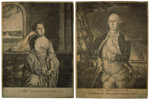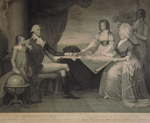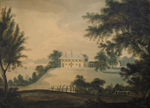|
Section I Selections from the C.W. McAlpin Collection
Section I Selections from the C. W. McAlpin CollectionSection IIIWashington’s Home and Family In 1759 Washington married Martha Dandridge Custis, a wealthy widow, and the couple, together with Martha’s two children, John Parke Custis and Martha Parke Custis, moved to Mount Vernon. After the premature deaths of both children, the Washingtons raised Martha’s two youngest grandchildren, Eleanor Parke Custis and George Washington Parke Custis. Washington’s family had been in possession of land along the Potomac River since 1674. When Washington legally inherited the Mount Vernon estate in 1761, he had already been in residence there for more than a decade. Over the course of the following four decades he expanded and improved the residence, and enlarged the property to an 8,000-acre plantation. He designed the grounds to include five working farms, as well as woods, meadows, walkways, gardens, and orchards. The estate was very nearly a self-sufficient community.
This pair of prints, few impressions of which are known, was once attributed by Charles Henry Hart to Charles Willson Peale, but the prints have since been credited to Major Joseph Hiller, Sr., a silversmith and portrait engraver active in Massachusetts. They are based on a pair of portraits painted by Peale in 1776 for John Hancock, then president of the Second Continental Congress. The painted portrait of Washington, now in the Brooklyn Museum, was the second one that Peale painted from life. The background depicts Charlestown, the site of the Battle of Bunker Hill and a reference to Boston, Hancock’s city of residence. This likeness of Washington was extensively copied both in paintings and prints, and widely distributed in the colonies and abroad. Indeed, three prints on view here (by or attributed to Le Mire, Revere, and Norman) are indebted to this image or copies of it. The current whereabouts of Peale’s painting of Mrs. Washington is unknown, but this print is evidently the first engraved portrait of her.
Washington is shown here with his wife, Martha; her grandchildren (whom Washington adopted after the death of their parents), George Washington Parke Custis and Eleanor Parke Custis; and William Lee, a slave who served as Washington’s valet. The map in the center of the image depicts the city of Washington, then in its early stages of construction. The precise location for the national capital was chosen by the president in 1790. Martha’s fan appears to indicate the site of the capitol building, which the president also selected, and for which he laid the cornerstone in 1793. This print had enormous financial success, and Washington himself purchased four impressions of it.
The only clue to the authorship of this watercolor is the inscription “A.F.P.K. fec’t” on the verso. The identity of A.F.P.K. remains a mystery, but the composition is nearly identical to two other depictions of Mount Vernon in the Print Collection: a watercolor, in the Emmet Collection, painted by George Washington Parke Custis when he was a boy; and a print in the Phelps Stokes Collection by Francis Jukes, dated 1800, after a drawing by Alexander Robertson probably done in 1799. Like Custis and Robertson, A.F.P.K. focuses on the bucolic beauty of Washington’s estate, which essentially dwarfs the manor house. The view takes in the highlight of the residence: the east-facing back porch and its dramatic vista of the Potomac River. Washington had a lifelong devotion to land. His first career was as a surveyor, and between the French and Indian and Revolutionary wars he was a dedicated and innovative farmer and agriculturist. During his absence he continued to be very involved, by correspondence, in the day-to-day affairs of the plantation. Judging from this image, it is no wonder that Washington was rather reluctant to leave his modern-day Arcadia to serve as commander in chief and then as president.
|



